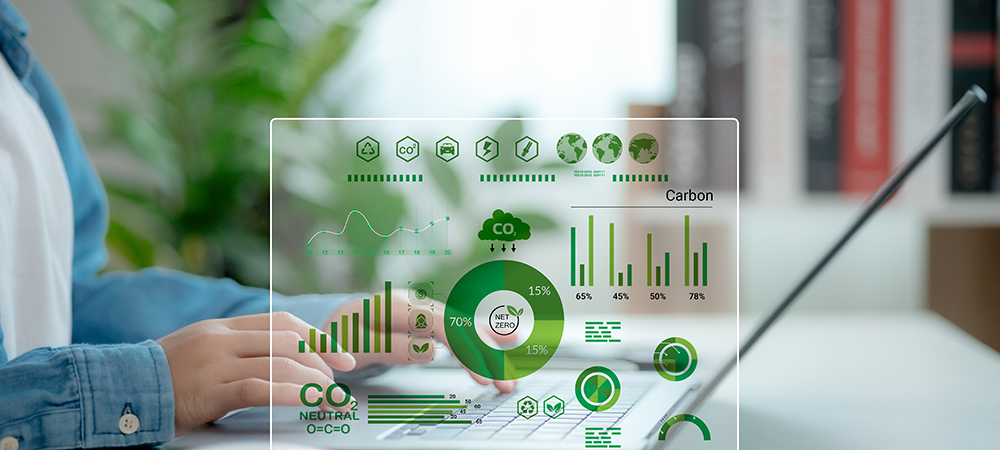Satish Thiagarajan, Founder of UK IT consulting firm, Brysa, delves into the growing role of technology in carbon accounting.
Tracking and reducing carbon footprint is arguably one of the toughest challenges staring at companies today. With the EU’s Corporate Sustainability Reporting Directive (CSRD) and Carbon Reporting Regulations breathing down their necks, business owners no longer have the luxury of time to offset their emissions and reach the desired sustainability levels.
Manual techniques for carbon accounting will not work in an era where time is money because they can be labour intensive, so it is important to embrace digital tools that can automate everything related to sustainability management, reducing the burden on companies.
The role of technology in carbon accounting
Technology is proving to be an ally for enterprises looking to streamline carbon accounting. Thanks to the capabilities of modern platforms, companies no longer have to worry about accuracy of emission data or spend a fortune on data collection and analysis, while measuring and trying to mitigate their environmental impact.
For starters, many carbon accounting platforms can automatically collect data from various sources such as energy consumption, supply chains, etc. This ensures accurate calculations of Scope one, two and three emissions, using technologies such as Internet of Things (IoT) and Artificial Intelligence (AI). IoT sensors, for instance, monitor energy usage and emissions levels while transmitting real-time data to AI-driven platforms. They can even consider the environmental impact of transmitting the data. AI platforms then analyse patterns and recommend strategies to reduce carbon emissions. Ultimately, your sustainability efforts are fully optimised.
Then there are technologies powered by Blockchain that ensure the integrity and transparency of data, for example, across a supply chain. This is achieved by creating an immutable ledger of emissions data, preventing data manipulation and creating verifiable records for regulatory compliance.
Cloud-based carbon accounting platforms offer great scalability for businesses that are growing quickly. Such platforms allow even small- and mid-sized businesses to track and report emissions without help, in a very cost-effective way and can enable real-time access to sustainability data. This helps decision-makers with actionable insights on live data 24/7 to drive carbon reduction initiatives.
Finally, we have dedicated carbon footprint calculators that help assess your environmental impact. These calculators align with international reporting standards such as the Greenhouse Gas Protocol, CDP (Carbon Disclosure Project), etc. Their goal – to ensure uniformity in emissions measurement and disclosure across industry sectors, suppliers and regulators
Common challenges when implementing carbon accounting technology
Incorporating carbon accounting software into your existing IT stack can be quite daunting. This is particularly true for those companies who are using legacy infrastructure. Tying all the tools together will be costly, time-consuming and labour intensive. If you are planning to leave them disconnected and working in isolation, this is a bit like operating with one hand tied behind your back – disconnected systems can do more harm than having no system at all.
The second challenge is identifying a reputed carbon accounting tech provider. The market is inundated with hundreds of carbon accounting platforms, making the task of finding the ideal one that much more difficult. To overcome this challenge, you should assess the platform’s capability set and see if it offers all your must-have features.
Thirdly, sustainability efforts require engagement at all levels of an organisation. Without proper training and a cultural shift towards environmental accountability, your employees may resist adopting new systems. This often leads to underutilisation of the technology and sets a project up for failure
Finally, implementing carbon accounting technology involves upfront costs. You need to assess the ROI and identify cost-effective ways to deploy these solutions without straining your budgets.
How to successfully implement carbon accounting technology?
Here is a structured approach to implementing carbon accounting technology for your business:
● Establish your sustainability objectives: Define what success looks like for your organisation. Whether it’s cutting emissions or improving efficiency, having clear goals at the start will help you choose the most suitable carbon accounting solution.
● Find the best-fit platform: Select a tool that aligns with your sustainability priorities. Prioritise platforms that have features including:
- Automated data collection from multiple sources
- Scope one, two and three emissions calculations
- Compliance with GHG Protocol, ISO 14064 and other standards
- Customisable dashboards and real-time tracking
- Regulatory reporting for CDP, TCFD, SECR, CSRD
- Scenario modelling for emission reduction
- Carbon offset marketplace integration
- Benchmarking and trend analysis tools
- Role-based access and workflow automation
- Secure, cloud-based platform with audit logs
● Get stakeholders on board: Successful implementation requires input from multiple teams. Engage members from different teams like finance, IT and operations. This will not only ensure smooth adoption and everyone can contribute towards your sustainability goals.
● Train teams for seamless adoption: For maximum impact, employees must be comfortable using the platform. Conduct hands-on training sessions and workshops after adopting the platform. Provide user-friendly guides and ongoing support to flatten the learning curve.
● Test before full rollout: Instead of jumping straight into full deployment, run a trial phase with a select group. This allows you to spot potential roadblocks and fine-tune processes. Finally, you can incorporate user feedback and slowly scale up.
● Track progress and scale over time: Once the system is in place, continuously assess its performance. Monitor key metrics and make necessary improvements. Slowly expand usage as sustainability goals evolve.
Embracing technology for a sustainable future
Carbon accounting technology is more than a compliance ally for your business. It’s an asset for those looking to reduce their environmental impact and gain a competitive advantage in an increasingly eco-conscious marketplace. But the key is investing in the right tools as they will help you chart out a path for a greener and more resilient future.




